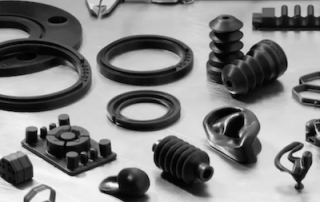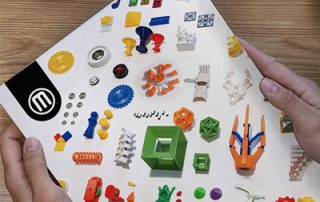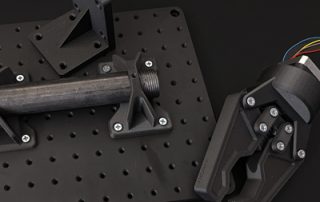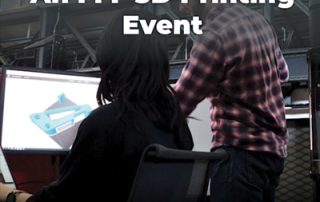Formlabs Introduces New BioMed Elastic 3D Printing Resins
Formlabs recently announced two new 3D printing resins materials for direct 3D printing of elastomeric, biocompatible medical devices and models. BioMed Flex 80A Resin and BioMed Elastic 50A Resin further expand 3D printing possibilities in medical device and medical component manufacturing as well as at the point of care in hospitals and in medical service bureaus. NEW! 3D Printing BioMed Elastic 50A Resin Soft, elastic, medical-grade material Suitable for applications requiring: Comfort Biocompatibility Transparency ISO 10993 and USP Class VI certified Manufactured in an FDA-registered, ISO 13485 facility Appropriate for use in applications for: Long-term skin contact (> 30 days) Short-term mucosal membrane contact (<24 hours) NEW! BioMed Flex 80A Resin Firm, flexible, medical-grade material Suitable for applications requiring: Durability Biocompatibility Transparency ISO 10993 and USP Class VI certified Manufactured in an FDA-registered, ISO 13485 facility Appropriate for use in applications for: Long-term skin contact (>30 days) Short-term mucosal membrane contact (<24 hours) Learn More
New 3D Printing Materials and Hardware From Formlabs
New 3D Printing Materials Capabilities Unlock Manufacturing Possibilities Though Formlabs has been at the forefront of hardware development for over a decade by bringing industrial power to an accessible price point with the Form Series SLA printers and Fuse Series SLS printers, our materials development team has matched the pace of innovation by developing over 40 proprietary materials and unlocking new applications for every industry. With their two new SLA resin materials, Silicone 40A Resin and Alumina 4N Resin, they are challenging the idea of what 3D printed parts can do. Silicone 40A Resin is the first accessible pure silicone 3D printing material made possible by their patent-pending Pure Silicone Technology™, that combines the outstanding material properties of cast silicone with the benefits of 3D printing. Though pure silicone materials have existed for 3D printers for years, their exorbitant price or low-quality have limited the possibilities for functional prototypes or high-quality end-use parts. Silicone 40A Resin brings the accessibility and affordability that Formlabs is known for together with the reliability, consistency, and familiarity of pure silicone made through traditional methods. Technical ceramics are used everywhere in manufacturing and engineering. And though 3D printing is becoming nearly as ubiquitous, combining the two technologies has [...]
3D Printing in the Classroom – a Free Guidebook
Are you interested in incorporating 3D printing into your classroom? The MakerBot Educators Guidebook is a great resource that provides practical tips and strategies for navigating the learning curve and maximizing the benefits of this innovative technology for student engagement and learning. You can download a free PDF of the guidebook here: MakerBot Educators Guidebook The guide covers a variety of topics, including: getting started with 3D printing in the classroom inspiring curriculum project ideas across various subjects valuable insights and tricks from experienced teachers who have successfully integrated 3D printing into their classrooms We hope you find this guidebook useful. For more information on purchasing a MakerBot 3D printer, please click below. Download the Guidebook More Details
Using Carbon Fiber Composites to Enhance Jigs and Fixtures
Jigs and fixtures are essential tools on any assembly floor, test lab, or machine shop. In this article, we will discuss what they are and how you can supercharge your jigs and fixtures by 3D printing them using carbon fiber composites. What are jigs and fixtures? Before diving into the benefits of carbon fiber composite 3D printing, let's clarify what jigs and fixtures are and why they are critical aids that can make the manufacturing process more efficient, precise, and safe. Jigs A jig is a custom-made tool that is employed to ensure precision and repeatability in manual processes like drilling, welding, and assembly. The primary purpose of a jig is to maintain consistency when producing duplicate parts and ensuring that each part aligns perfectly with the others. Simply put, a jig acts as a template, guiding the tool to the correct position on a workpiece. Fixtures Unlike jigs, fixtures are used to hold a workpiece in place during operations. They ensure that the piece remains stationary, allowing tools or machines to function accurately. Fixtures are specifically designed to fit a particular part or shape, ensuring that the workpiece is held in the exact position and orientation required for the manufacturing process. An [...]
You’re Invited to a 3D Printing BBQ
Food, Fun & Filament: An FFF 3D Printing Event Join us on October 18th at our headquarters in Branchburg, NJcim for a mouthwatering adventure as we combine the smoky delights of a BBQ feast with the cutting-edge wonders of the UltiMaker Method XL 3D printer. Tantalize your taste buds and spark your creativity with this free event. Immerse yourself in the world of 3D printing with a close-up look at our three dedicated 3D printer rooms. During the tour, you'll have the opportunity to engage with our 3D printing experts and gain invaluable knowledge about all of our 3D printer solutions, including the Method XL. Witness the future of manufacturing with an educational presentation given by our experts on the trends in 3D printing that lead to the Method XL and how it fits within these trends. The Method XL is good for intricate prototypes to functional parts with its large build envelope and unmatched reliability. Free Registration Here
Deploying the Measure Functions within Control X Professional
In this month’s Metrology Minute, we are going to explore the various measurement tools available within Control X. Most of the time, when inspecting parts using Control X, we compare feature sizes and shapes to nominal CAD models. However, the Measure Tool allows you to request typically required measurements needed for analyzing manufactured part features, such as calculating rough distances. Two points are selected on the mesh or point cloud data and the distance between these points is returned. Additionally, various alignment tools are also offered with some of the Measurement Tool options. In this case, we just want a distance calculation with no axis modifier used for alignment. The information is returned to the Measurement Node in the Model Manager, to then be used in reporting. Each of the Measure options will appear in this same Measurement node. The Measure Angle function enables you to select three points from the mesh or point cloud and Control X will return the angle between them. When measuring the angle from an analytic shape, the Fitting Geometry checkbox can be selected to allow the result to be best fit to an analytic part feature. In the case of the airfoil, analytic geometry isn’t used. The [...]







